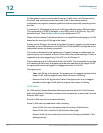
VLAN Management
Voice VLAN
179 Cisco Small Business 200 Series Smart Switch Administration Guide
12
- Forbidden—The interface is not allowed to join the VLAN. When a port is
not a member of any other VLAN, enabling this option on the port makes
the port part of internal VLAN 4095 (a reserved VID).
- Excluded—The interface is currently not a member of the VLAN. This is
the default for all the ports and LAGs when the VLAN is newly created.
- Tagged—Select whether the port is tagged. This is not relevant for
Access ports.
- Untagged—Select whether port is untagged. This is not relevant for
Access ports.
- PVID—Port PVID is set to this VLAN. If the interface is in access mode or
trunk mode, the device automatically makes the interface an untagged
member of the VLAN. If the interface is in general mode, you must
manually configure VLAN membership.
STEP 5 Click Apply. The settings are modified and written to the Running Configuration
file.
STEP 6 To see the administrative and operational VLANs on an interface, click Details.
Voice VLAN
In a LAN, voice devices, such as IP phones, VoIP endpoints, and voice systems are
placed into the same VLAN. This VLAN is referred as the voice VLAN. If the
voice devices are in different voice VLANs, IP (Layer 3) routers are needed to
provide communication.
This section covers the following topics:
• Voice VLAN Overview
• Configuring Voice VLAN
Voice VLAN Overview
This section covers the following topics:
• Dynamic Voice VLAN Modes
• Auto Voice VLAN, Auto Smartports, CDP, and LLDP


















